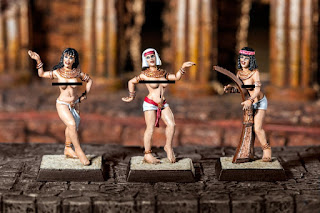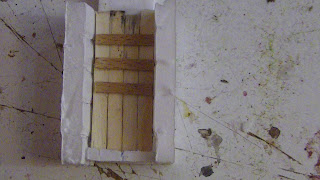Syracuse was a city of Greater Greece, located on the east coast of Sicily. The city was founded in 734 BC by Greek settlers from Corinth.
In its history, as an independent city, it was governed by tyrants, interspersed with short democratic and oligarchic periods. In 304 BC, the tyrant Agathocles took the title of king (basileus), title taken up by his successors.
Syracuse remained independent until 212 BC, when it was conquered by the Romans during the Second Punic War. It later became the seat of Roman domination in Sicily.
My army, constituted in BBDBA format, represents the Syracusan army in 212.
The figurines used are those photographed in the page devoted to the classical Greeks. On the other hand, some particularities concern the typically Syracusan platelets.
Some Carthaginian figurines are integrated on platelets to represent the use of Punic material (coats of mail, helmets ...) by some Syracusan hoplites.
Some shields bear motifs copied from Syracusan coins.
The army also employs a few mercenaries: two Iberian plates and a plate of Ligures. It is also possible for him to align Gauls (4Wb), which I do sometimes using my Gaulois bases (alas basement in 3Wb)
 |
| Iberian mercenaries |
 |
| Ligurian mercenaries |
Archimedean mirrors
In 215 BC, Archimedes organized the defense of Syracuse in the face of the invasion of the Romans and of General Marcellus during the Second Punic War, during which the inhabitants of Syracuse had allied themselves with the Carthaginians after being the allies of Rome for nearly half a century.
For three years he built war machines to resist the Roman galleys facing Syracuse.
Anthemius of Tralles (474-534) tells the story of the use of catapults and fiery mirrors in this battle become legendary
.Référence:
Le cabinet de physique de Sigaud de Lafond

The use of mirrors as a weapon in themselves is impossible according to archaeologists. Experimental archeo attempts are best at 160 ° C, well below the 350 ° required to ignite a trireme.
The pointer hypothesis relies on the need to group several projectiles on the same target. The target ship is designated by the mirror. A priori, several bronze plates (an article even speaks of hexagonal shapes but I do not know why) Several ballista with flaming features then unite their shots against the same ship.
On the other hand, it goes without saying that this mirror is in no way fixed on a ballista itself.
I think of the general shape of the mirror of Lavoisier by adding pivots to the mirror itself (for the general form, I know well that for Lavoisier, it is quite different since the sun is directed towards the rear of the craft ). But that will be for later, when I will tamper with my current balistes. At least one of the balists will not be transformed in order to be able to be aligned, without a mirror, in other Greek armies than that of Syracuse (Phocaeans)
The version chosen by Greg Kelleher for his 15mm Syracusan army. He seems to have opted for the weapon mirror. Even if it's impossible, it gives a funny thing:
The archimedes balistes as I presently represent them (two of them will later be endowed with a mirror.
These ballista are Hät 1/72 plastic (with servants 28mm foundry) The rendering is nice and the low cost (about 5 € for 4 pieces of artillery)























































